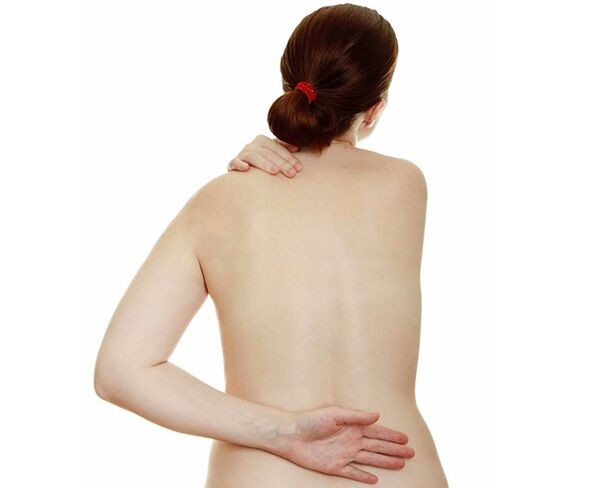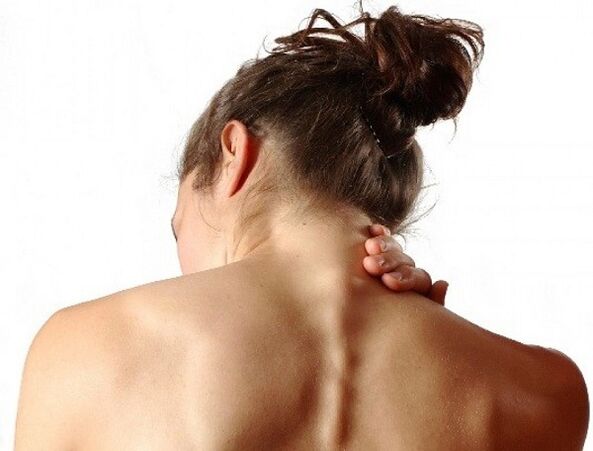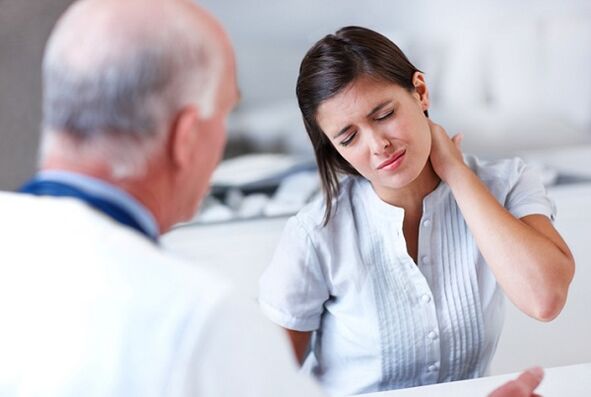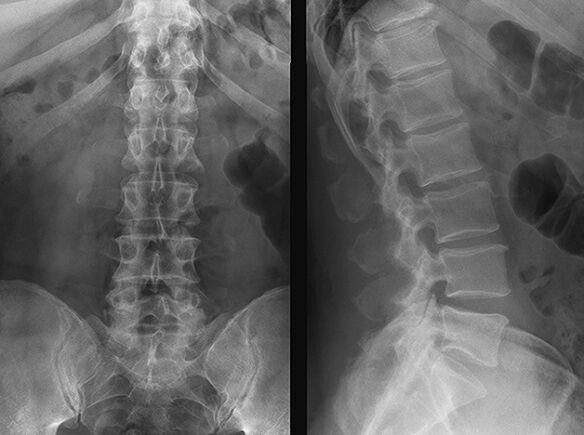Osteochondrosis is a disease of the spine in which cartilage and joints undergo degenerative disease. It is characterized by thinning of the intervertebral disc and decreased elasticity.
Disease characteristics
This disease mainly affects the elderly. Although scientists have noticed that more and more manifestations of this disease begin at the age of thirty, or even earlier. This shows that the disease has become younger.

Intervertebral discs provide shock absorption, but in the case of illness, they cannot complete the task. People with osteochondrosis almost always complain of pain, and the pain can be local and distant. A person feels motor stiffness, lethargy and fatigue.
Basically, pain is manifested in the part affected by the disease.
Pathological location and its types
According to which part of the spine is pathologically damaged, 4 types of osteochondrosis can be distinguished:
- Cervical osteochondrosis. . . It happens in the case of cervical spine disease. The vertebrae become fragile and the load on the cervical spine increases, which may cause the thyroid to rupture and squeeze the arteries that supply blood to the brain.
- Thoracic osteochondrosis. . . Pathological changes in the thoracic spine. Compared with other types, it is less frequently diagnosed in patients because the thoracic spine has lower mobility and is protected by stronger muscles. This type of symptoms is similar to cardiovascular disease.
- Lumbar osteochondrosis. . . This type is the most common. Because the lumbar spine has the greatest load.
- combination. . . It happens when several parts of the spine are damaged at the same time.
At the same time, this disease can also affect other joints. In most cases, they suffer:
- Shoulder joint. . . Usually, the disease is caused by the transition from cervical osteochondrosis to the shoulder joint.
- hip joint. . . It occurs due to changes in cartilage tissue and lack of fluid between joints.
- Knee joint. . . rickets can manifest in 3 forms:
- Koenig's disease, in which cartilage tissue is affected.
- Larsen-Johansson disease, in which the joints above the knee change.
- Osgood-Schlatter disease is related to changes in the tibia.
Classification and manifestation of the disease
The disease can be classified according to its degree of manifestation. At the same time, it is difficult to determine the extent of the disease before the onset of characteristic pain. The disease has 4 manifestations:
- The initial stage of disease development. It occurs due to disc displacement associated with careless weightlifting. It is characterized by unstable pain. At this stage, the disease is difficult to diagnose, but it is easy to treat.
- This stage is characterized by the gradual destruction of the intervertebral disc, drying out and loss of shock absorption properties. This leads to increased tension in blood vessels and nerve endings. The pain will increase and is most noticeable during physical exertion and sudden movement. At this stage, the treatment of the disease is conservative.
- The annulus fibrosus was destroyed and intervertebral hernia occurred. The spine is deformed. The pain became obvious. It can only be treated by surgery.
- At this stage, due to the formation of osteophytes, the vertebrae grow together. The spine tissue is compressed, the vertebrae lose their mobility and restrict people's movement. At this stage, the disease causes disability and is no longer suitable for treatment.
Typical symptoms
Each disease has its own symptoms. Therefore, for example, the characteristics of cervical osteochondrosis are:
- Pain in the arms and shoulder straps.
- headache.
- Dizziness and spots in front of the eyes.
- Unstable blood pressure.
- Loss of sensitivity in fingers.
- tinnitus.
For the pathology of the chest area, the symptoms are characteristic:
- Pain in the heart area.
- Painful feelings in hypochondriasis.
- Lack of air due to the severe pain of the shooting nature.
When the disease is limited to the lumbar spine, there are:
- Pain in the lower back.
- Decreased leg sensitivity.
- Radiating pain in the leg.
- Violation of pelvic organs.
There are some general symptoms that do not depend on disease location:
- Back pain.
- Muscle cramps.
- Limit movement.
- The changes in the pain syndrome depend on the load and sudden movements.
- Numbness in limbs.
- Fast fatigue.
- Sensitivity of the limbs is reduced.

Signs and manifestations of osteochondrosis
The first signs of the disease begin to appear in the first stage of development. These include:
- Swelling and pain in the waist after lying down in one position for more than half an hour.
- Back pain after sitting for a long time.
- Need to stretch after waking up, unable to wake up and get up immediately.
- Feel the back tightening.
- Goose bumps and weakened sensation in the limbs.
- An unpleasant sensation in the back when bending over.
- General weakness.
- Violation of reproductive function and the work of internal organs.
In addition, osteochondrosis can manifest as pain during weight lifting and physical activity.
Pathological diagnosis method
Various methods are used to diagnose osteochondrosis. This includes:
Preliminary examination and inquiry of the patient:
- Interview patients to clarify the main complaint and the duration of the onset of symptoms.
- Examine the patient's body and study the posture, gait and movement.
- Palpate the problem area.
- Determination of pain sensitivity.

Instrument diagnosis:
- X-rays help identify the deformation of the intervertebral disc.
- MRI to determine the presence and location of a herniated disc.
- Computed tomography is similar to magnetic resonance imaging in its performance, but has a greater degree of radiation.

Ways to treat diseases
After performing the diagnostic procedure and diagnosing osteochondrosis, the doctor will prescribe an appropriate treatment plan.
Since osteochondrosis can only be treated in the first stage of development, all major measures are mainly aimed at alleviating pain. To do this, please apply:
- drug.
- physiotherapy.
- Manipulative therapy.
- Massage therapy.
- diet.
As a drug treatment, non-steroidal anti-inflammatory drugs are used. They are designed to relieve the inflammatory process in the diseased area and prevent pain.
Cartilage protective agents are also used to repair cartilage tissue. In order to maintain the normal functions of the body, immunostimulants and vitamin complexes are used.
Physical therapy methods aim to suppress pain, normalize the metabolic process in the affected area, improve blood circulation, and relieve inflammation and edema. These include:
- acupuncture.
- Magnetic therapy.
- Electrophoresis.
- Laser Treatment.
- Paraffin therapy.
Compared with drug therapy, physical therapy methods help to shorten the treatment time and have fewer side effects.
Manipulative therapy is the dose effect of the doctor's hand on the affected area of the back to eliminate restrictions that interfere with the normal function of joints, muscles, and ligaments.
Therapeutic massage can only be performed by a specialist and aims to relieve muscle tension, restore displaced vertebrae, and normalize blood circulation. This procedure should be performed at least 3 times a week.
The osteochondrosis diet aims to normalize body weight, improve blood circulation, replenish collagen, eliminate calcium and mineral deficiencies, and help control fluid and salt intake. The diet should be balanced and contain a lot of plant foods. In the process of fighting osteochondrosis, such foods must be eliminated: coffee and strong tea, foods rich in salt and sugar, carbonated drinks and high-fat foods.
In these processes, the disease can be corrected, and surgical intervention is only needed in difficult stages.
Precaution
In order to prevent this disease, it is necessary to develop a healthy lifestyle, get rid of bad habits, exercise more, sleep with orthopedic mattresses and pillows, avoid wearing uncomfortable shoes, and it is best to use orthopedic shoes.
You should also monitor your diet and maintain a healthy weight. In a static state for a long time, it is necessary to allocate time for exercise that helps normalize blood circulation.
In addition, in order to prevent and prevent diseases, you can receive healing treatments and full-body intensive massage.


























